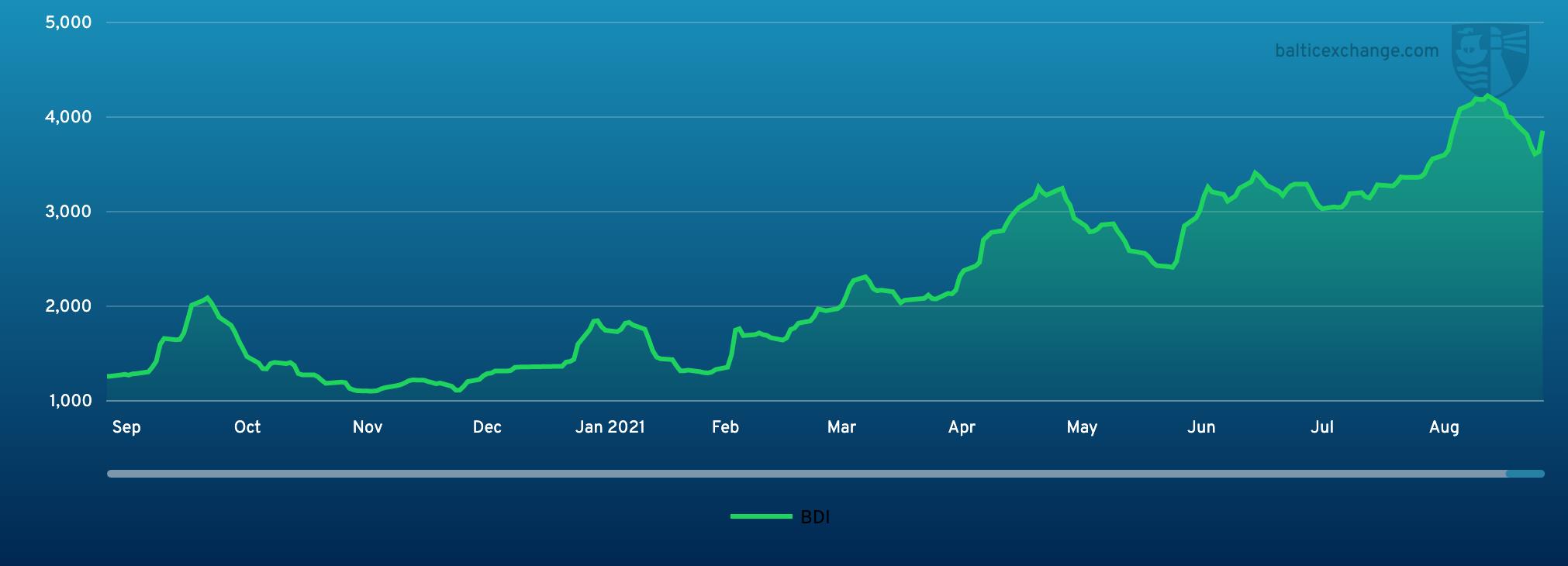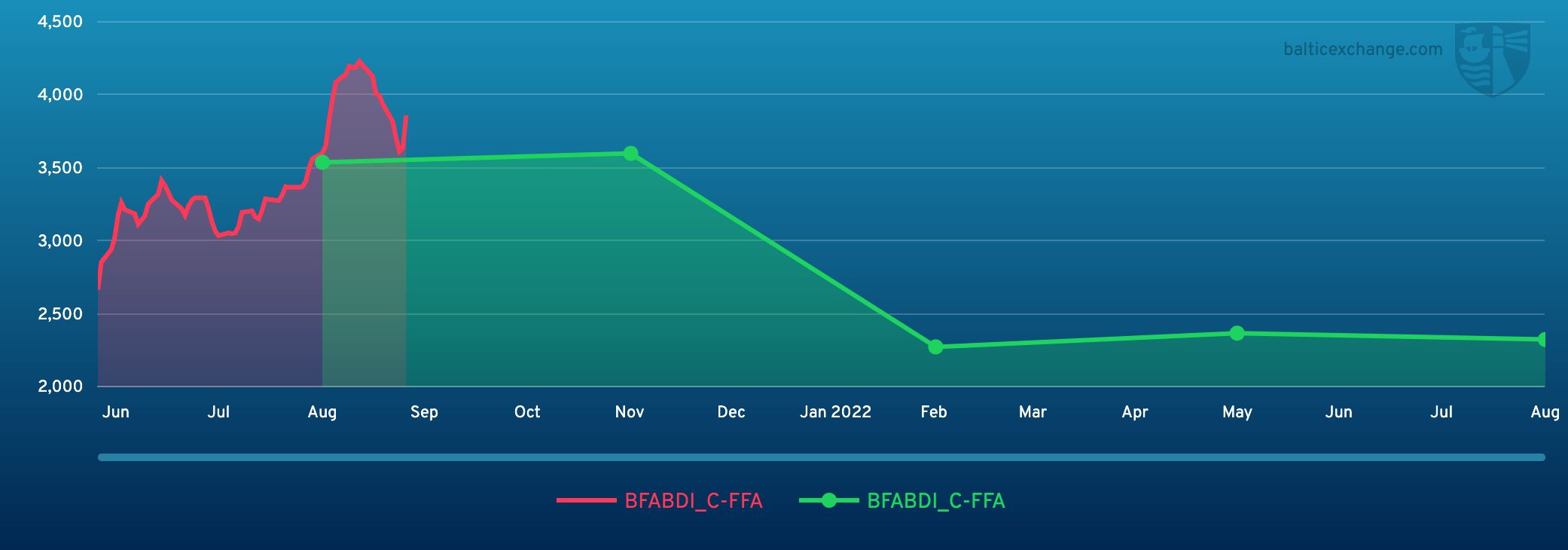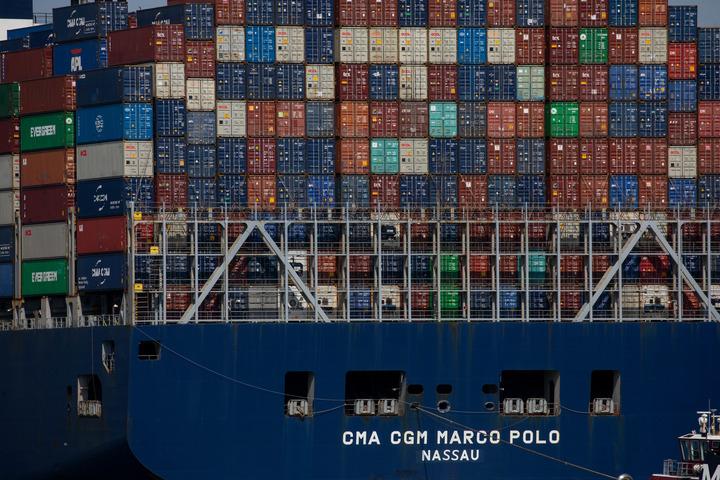BEIJING, Sept. 14 (Xinhua) -- The Baltic Exchange has published its weekly report of the dry and tanker markets for Sept. 6-10, 2021 as below:
Capesize
The Capesize market staged a dramatic turnabout at weeks end after seeing several days of value eroded off each route in the market. Closing last week at $46,647 the market took losses down to $40,518 before surging 5,021 on Friday to close this week out at $46,172. The market change is sure to have left many traders bewildered, yet this is well known to happen in the Capesize sector. Throughout the week the Transpacific C10 was largely responsible for much of the poor sentiment, as it settled up 4,589 to close at $41,954. The Transatlantic C8 was more resistant yet was eroding under the weight of the other routes. Come the close it lifted 9,575 to $57,500. The West Australia to China C5 ended the week well above where it began rising to $14.155 while the Brazil to China C3 couldn’t quite mange the same, posting at $31.80. The momentum direction is strongly up so the question for next week is not whether it will continue to rise but possibly by how much.
Panamax
It proved to be a varied week for the Panamax market. A tepid start, but with some solid support midweek we end on a firmer feel. Despite a dearth of authentic transatlantic demand, rates picked up largely due to a tight north Atlantic tonnage count and a week in which the quicker Baltic coal round trips came to the fore. A midweek push saw end September/early October arrival loading out of EC South America find some support, with various rumours emerging. In Asia, a similar pattern played out for the early part with congestion ex China easing against a frail looking cargo list. Rates softened, only for them to find support later in the week with better demand. A 82,000dwt delivery North China agreed $32,750 for a NoPac round trip roughly the mean average on the week. A 82,000dwt achieved $30,750 for 11/13 months period basis a China delivery.
Ultramax/Supramax
A rather lacklustre week for the sector with limited fresh enquiry from areas such as the US Gulf after the recent hurricane and limited enquiry from south east Asia leading to greater tonnage availability. However, as the week ended some said a bottom might have been reached as rates seemed to be hovering around last done. Limited period activity surfaced, a 64,000dwt open CJK fixing at around $29,000 for one year. In the Atlantic, limited fresh enquiry from east coast south America, but a 56,000dwt was heard to have been fixed in the mid to upper $30,000s for a trip to Algeria. Elsewhere, a 57,000dwt open west Africa was heard fixed for a trip to the eastern Mediterranean at $31,000. From Asia, a 59,000dwt open Philippines was linked to a trip via Indonesia redelivery Thailand at $35,000. At the beginning of the a 55,000dwt open north China was fixed via ROK trip redelivery west coast India at $35,000.
Handysize
This week has seen the US Gulf Market soften with the aftermath of the Hurricane still causing issues for cargo supply on what was an inactive market. Some Owners decided to ballast away to both South America and some towards the Continent and Mediterranean regions in search of their next employment. A 30,000dwt was rumoured to have fixed for Puerto Bolivar to Morocco with an intended cargo of coal at $16,000. A 37,000dwt open in Cristobal ballasted to Fazendinha to fixed a trip to the Continent with grains at $21,000. South Brazil has rallied in the last few days with a 37,000dwt rumoured to have fixed a trip from Upriver Plate to the Baltic at around $36,000. In Asia a 28,000dwt open in China was fixed for two Laden Legs at $28,000. A 34,000dwt was rumoured to have fixed for minimum of seven months from the Western Mediterranean region at $35,000.
VLCC
A buzier market saw a few more fixtures this week and rates marginally improved in the East and West. In the Middle East Gulf region the rate for 280,000mt to US Gulf (routing via the Cape/Cape) remains steady at the WS18/18.5 level mark, while 270,000mt to China saw a half point gain to just over WS34 (a round trip TCE of about minus $1.9k per day).
In the Atlantic, rates for 260,000mt West Africa to China rose a modest point to a fraction below WS35 ($860 per day TCE roundtrip) and 270,000mt US Gulf to China rose $156k to $4.131m (a TCE of $1.8k per day roundtrip).
Suezmax
In West Africa more availability of tonnage has had a negative impact and the rate for 130,000mt Nigeria/UK Continent is down 2.5 points to WS52/52.5 level (a round trip TCE of $200 per day). Rates for 135,000mt Black Sea/Med eased two points to WS60 (showing a TCE round trip of minus $5.8k per day).
The Middle East market saw Repsol and Litasco fixing from Basrah to Spain and Greece respectively at around WS23.5 levels although the Baltic Exchange voyage of 140,000mt Basrah/Lavera is still assessed at around the WS24.5/25 level.
Aframax
In the Mediterranean, 80,000mt Ceyhan/Lavera dropped a point to just above WS86 (about $1.4k per day TCE roundtrip) while in Northern Europe 80,000mt Cross-North Sea similarly eased a point to WS91.5 (a round trip TCE of minus $5.7k per day). Rates for 100,000mt Baltic/UK Continent fell back three points to WS56 (a TCE of about minus $3.9k per day round trip). Across the Atlantic, the market has continued to climb with rates for 70,000mt Caribbean/US Gulf pushing up seven points to WS113 (a TCE of $8.4k per day round trip) and 70,000mt East Coast Mexico/US Gulf up eight points to WS123 (a round trip TCE of $13.2k per day). Rates for the 70,000 US Gulf/UK Continent trip have also risen, up five points to WS97.5 (a TCE of $6.1k per day round trip, and significantly higher for single trip economics).
Clean
The Middle East Gulf has been lacklustre this week putting pressure on a previously firming market. On the LR2s to Japan TC1 has dropped 7.5points to WS106.25, a round-trip TCE of $9,772/day. The LR1s saw some activity mid-week, but after the slow start and a build-up of tonnage rates have been retested down, TC5 55k Middle East Gulf / Japan is now in the WS112.5 region. On the MR’s, 35k Middle East Gulf / East Africa (TC17) also dropped 31 points to WS192, a round-trip TCE of $11,265/day. Despite an increase in enquiry the Mediterranean Handy market has had plenty of available tonnage to handle and TC6 30k Skikda / Lavera is holding around WS110-112.5 mark. The LR2's looked to have potential to firm. However, this did not materialise and TC15 80k Mediterranean / Japan is still around $1.7m. The Baltic Handy market has followed the MRs this week, and TC9 30k Baltic / UK-Continent dropped WS22.5 to WS120. On the UK-Continent, MR freight levels seem to have reached a floor. TC2 37k UK-Continent / US Atlantic Coast has been repeated at WS100. TC19 37k Amsterdam to Lagos has also seen a similar dip to WS101.67 a round trip TCE of $1,435/day. With vessels still ballasting towards the region, there is potential for rates to be tested further next week. On the LR1s, TC16 60k Amsterdam / Offshore Lome remains static at WS85 for the moment. In the Americas all parties are patiently waiting as the region continues to focus on recovery from the recent bad weather. Freight levels have stayed sideways and TC14 38k US Gulf / UK-Continent is still in the WS60 region whilst TC18 35k from US Gulf / Brazil is pegged around WS100. The MR Atlantic basket TCE dropped from $1,386/day to $762/day.
Headquartered in London and a subsidiary of the Singapore Exchange (SGX), the Baltic Exchange publishes a range of indices and assessments which provide an accurate and independent benchmark of the cost of transporting commodities and goods by sea. These include the Baltic Dry Index (BDI), the dry bulk shipping industry's best known indicator. Published daily since 1985, this provides a snapshot of the daily spot market earnings of capesize, panamax and supramax vessel types on the world's key trading routes.

Chart shows Baltic Dry Index (BDI) during Sept.10, 2020 to Sept. 10, 2021

Baltic Forward Assessment for BDI
In March 2018 the BDI was re-weighted and is published using the following ratios of time charter assessments: 40 percent capesize, 30 percent panamax and 30 percent supramax. The information is provided by a panel of international shipbrokers.
(Source: The Baltic Exchange, edited by Niu Huizhe with Xinhua Silk Road, niuhuizhe@xinhua.org)




 A single purchase
A single purchase









